Wind Ensembles
Bach - Prelude & Fugue - Wind Quintet
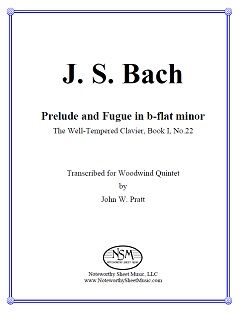 Prelude and Fugue, WTC Book I, No.22, by J.S.Bach
Prelude and Fugue, WTC Book I, No.22, by J.S.Bach
Transcribed for Woodwind Quintet by John W. Pratt, PDF $16.00
Score, 6 pages; Parts, 2 pages each for Flute, Oboe (plus alternate Alto Flute), Clarinet, Horn, and Bassoon; Total, 20 pages.
PreviewBach - Prelude and Fugue, BWV 532 - arr. Woodwind Quartet
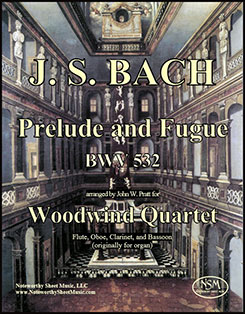 Prelude and Fugue, BWV 532, by J. S. Bach
Prelude and Fugue, BWV 532, by J. S. Bach
Arranged for Woodwind Quartet by John W. Pratt
Score and Parts, PDF $15.97
Click to listen to computer-generated audio samples from the score; audio clips from the Prelude (m4-22) and the Fugue (m14-27), are separated by a brief pause.
Score, 16 pages; Flute part, 5 pages; Oboe part, 6 pages; Bb Clarinet part, 6 pages; Bassoon part, 5 pages;Total, 46 pages.
PreviewBach - Toccata, Adagio, and Fugue - Wind Quartet
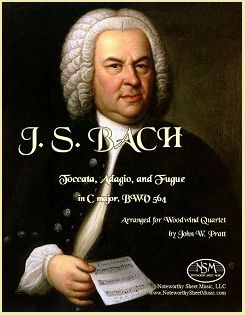 Toccata, Adagio, and Fugue in C major, BWV 564, by J. S. Bach
Toccata, Adagio, and Fugue in C major, BWV 564, by J. S. Bach
Arranged for Woodwind Quartet by John W. Pratt
Score and Parts for Flute, Oboe, Clarinet, & Bassoon, PDF $21.25
excerpted from JWP’s © foreword to the edition:
Among J. S. Bach's big organ works, the Toccata, Adagio, and Fugue, BWV 564 is atypical in ways that make it unusually well suited to transcription for woodwind quartet. Unlike most, it has a middle movement, an Adagio with an elaborate and gorgeous melody which lies comfortably for flute and can benefit greatly from the shaded, nuanced dynamics and articulations that a solo flutist can provide. The other winds bring out Bach's beautiful voice-leading in the Adagio's two inner parts and its marching but not martial bass. The four-part Fugue is unusual, too—light and lighthearted, happily adaptable to woodwinds, with no call for great power and, rather than a climactic ending, a fading coda that defies convincing treatment on the organ. The exuberant Toccata starts with an extended manual solo passage ... mostly in 32nd notes, which ... I felt it would be more effective as a game of frequent handoffs between instruments than as a series of longer individual études. The pedal solo, mostly 16ths, calls for the extra weight of doubling.
Click to listen to a computer-generated audio sample from the end of the Toccata into the beginning of the Adagio.
Score, 17 pages; Flute part, 6 pages; Oboe part, 5 pages; Bb Clarinet part, 5 pages; Bassoon part, 4 pages; Total, 46 pages.
PreviewBartók - For Children - arr. for Winds
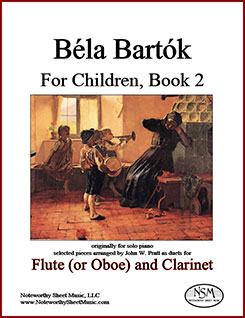 For Children, by Béla Bartók
For Children, by Béla Bartók
piano pieces based on Hungarian and Slovakian folksongs
Selected pieces arranged as woodwind duos, trios, or quartets by John W. Pratt and presented in multiple editions, organized by instrumentation and nationality.
Béla Bartók was not only a major composer in a post-Romantic extended tonal style, but he was also a superb pianist with a precise technique, a scholarly explorer of folk music, and a serious pedagog. Folk melodies and harmonies strongly influenced his music, both indirectly and often directly, including many of his orchestral and chamber works, as well as solo piano pieces ranging in difficulty from easy to virtuosic. His For Children (Gyermekeknek, 1908-1909, Sz. 42) was written for solo piano, and the original Books 1 and 2 contained 42 pieces after Hungarian folksongs and 43 pieces after Slovakian folksongs, respectively. Besides the usual purposes of music written for children, Bartók sought to broaden their musical experience with, for instance, modal and other scales, and harmonies outside the traditional western canon. For Children is by no means pablum; though the notes may be easy to play, these pieces have a lot else to offer. They were written when Bartók’s folksong research was well under way and his notational efforts at their peak. Students, teachers, and every-day players can make as much of them as they like ... as simple tunes for beginners content to learn basic notes and rhythms, or as more advanced studies on articulation, musicality, etc. —extracted from the preface by JWP
John Pratt has arranged selected pieces from the For Children books as various duos, trios, and quartets for wind instruments. As presented originally by Bartók, many of the folksongs are entirely or mostly in two voices, like Bach’s two-part inventions in style if not structure or harmony, and thus convenient for wind duo and no more childish for Bartók than Bach. Many others are also adaptable to duos of flute or oboe and clarinet or bassoon, mostly by spreading the left-hand chords in time. Still others of the For Children pieces are more suitable for a wind trio of flute (or oboe), B-flat clarinet, and bassoon, or a quartet of flute, oboe, B-flat clarinet, and bassoon. To compare the specific songs included in our editions with the complete set arranged for piano available in Bartók’s publications, visit the For Children listing on imslp.org.
All of the NSM editions described below are available as downloadable PDFs. We provide scores, but not separate parts, as all players can easily play off copies of the scores, which are organized for convenient page turns when the PDFs are printed two-sided in their entirety. Click the Preview button to view a page of the score from each edition. To order, in the table at the bottom of this webpage, check the box for the edition you would like to purchase, click Add to Cart, then click Checkout.
► Bartók - For Children, Book 1 - selected pieces arr. as Duets for Flute (or Oboe) and Clarinet 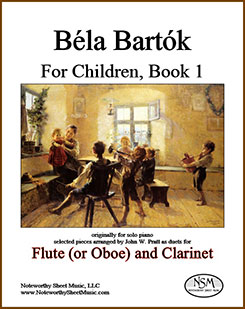 This edition includes 25 pieces from Book 1 arranged as duets; all of them can be played by B-flat clarinet and either flute or oboe, but for six of the pieces we also include alternative versions with octave changes that are better suited to oboe. The pieces included are Nos. 1-15, 22-26, 29, 31, 21, 40, and 42. Click to listen to computer-generated audio samples from the score; audio clips of #11 "Me and the Rain" with flute and clarinet and #32 "Wedding Day and Night" with oboe and clarinet are separated by a brief pause.
This edition includes 25 pieces from Book 1 arranged as duets; all of them can be played by B-flat clarinet and either flute or oboe, but for six of the pieces we also include alternative versions with octave changes that are better suited to oboe. The pieces included are Nos. 1-15, 22-26, 29, 31, 21, 40, and 42. Click to listen to computer-generated audio samples from the score; audio clips of #11 "Me and the Rain" with flute and clarinet and #32 "Wedding Day and Night" with oboe and clarinet are separated by a brief pause.
Score, 26 pages; Total, 30 pages.
Preview: Book 1, Flute (or Oboe) and Clarinet
► Bartók - For Children, Book 1 - selected pieces arr. as Duets for Oboe (or Flute) and Bassoon
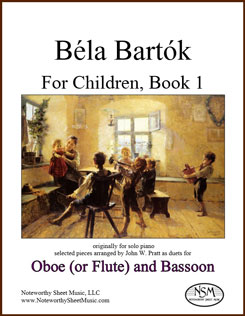 Our oboe (or flute) and bassoon edition includes the same 25 pieces from Book 1 as our flute and clarinet edition described above, except here they are arranged and optimized as duets for oboe and bassoon, with alternative versions better suited for flute and bassoon provided for two of the folksongs.
Our oboe (or flute) and bassoon edition includes the same 25 pieces from Book 1 as our flute and clarinet edition described above, except here they are arranged and optimized as duets for oboe and bassoon, with alternative versions better suited for flute and bassoon provided for two of the folksongs.
Preview: Book 1, Oboe (or Flute) and Bassoon
► Bartók - For Children, Book 2 - selected pieces arr. as Duets for Flute (or Oboe) and Clarinet

Our Book 2 edition of arrangements for flute (or oboe) and clarinet duo includes 23 pieces: Nos. 1-6, 8, 10-13, 16-20, 22, 25, 26, 29, 31, 35, and 36. All of these pieces can be played by B-flat clarinet and either flute or oboe, but we also include alternative versions that are more suitable for oboe for three of the pieces.
Score, 17 pages; Total, 22 pages.Preview: Book 2, Flute (or Oboe) and Clarinet
► Bartók - For Children, Book 2 - selected pieces arranged as Duets for Oboe (or Flute) and Bassoon
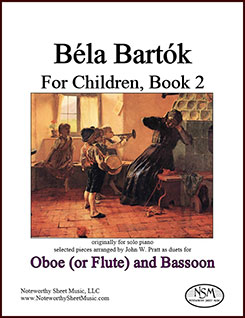 The oboe (or flute) and bassoon edition includes the same 23 pieces from Book 2 described above for flute and clarinet, here arranged and optimized as duets for oboe and bassoon, with an alternative version better suited for flute for one of the pieces.
The oboe (or flute) and bassoon edition includes the same 23 pieces from Book 2 described above for flute and clarinet, here arranged and optimized as duets for oboe and bassoon, with an alternative version better suited for flute for one of the pieces.
Preview: Book 2, Oboe (or Flute) and Bassoon
► Bartók - For Children, Book 1 - selected pieces arranged as Trios for Flute (or Oboe), Clarinet, and Bassoon
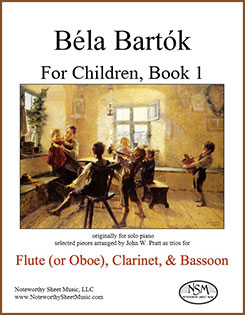 In this trio edition, we present 20 songs from Book 1, including 14 that are also available as duo arrangements in the editions listed above and 6 that are only offered in our trio edition. The pieces are Nos. 1-9, 11, 13-15, 19, 20, 30, 35, 39, 41, and 42. The trios are arranged for flute or oboe, B-flat clarinet, and bassoon. Click to listen to a computer-generated audio sample from #39 "Insect Wedding".
In this trio edition, we present 20 songs from Book 1, including 14 that are also available as duo arrangements in the editions listed above and 6 that are only offered in our trio edition. The pieces are Nos. 1-9, 11, 13-15, 19, 20, 30, 35, 39, 41, and 42. The trios are arranged for flute or oboe, B-flat clarinet, and bassoon. Click to listen to a computer-generated audio sample from #39 "Insect Wedding".
Score, 21 pages; Total, 24 pages.
Preview: Book 1, Flute (or Oboe), Clarinet, and Bassoon Trio
► Bartók - For Children, Book 2 - selected pieces arranged as Trios for Flute (or Oboe), Clarinet, and Bassoon
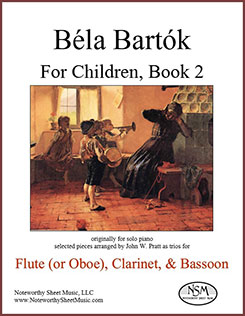 Here Mr. Pratt offers eighteen of Bartók’s Book 2 Slovakian folksongs in arrangements for a woodwind trio of flute or oboe, B-flat clarinet, and bassoon; the pieces included are Nos. 2, 3, 7, 9, 11-14, 16, 17, 21, 25, 26, 28, 29, 32, 33, and 42. Ten of these songs are also included in our duo arrangement publications.
Here Mr. Pratt offers eighteen of Bartók’s Book 2 Slovakian folksongs in arrangements for a woodwind trio of flute or oboe, B-flat clarinet, and bassoon; the pieces included are Nos. 2, 3, 7, 9, 11-14, 16, 17, 21, 25, 26, 28, 29, 32, 33, and 42. Ten of these songs are also included in our duo arrangement publications.
Preview: Book 2 Flute (or Oboe), Clarinet, and Bassoon Trio
► Bartók - For Children, Book 1 - selected pieces arranged for Wind Quartet (Flute, Oboe, Clarinet, and Bassoon)
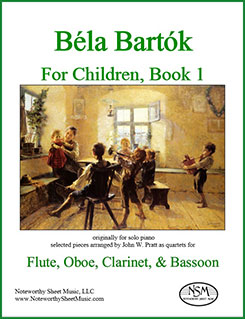 This edition includes eleven of Bartók’s Hungarian folksongs in arrangements for a woodwind quartet of flute, oboe, B-flat clarinet, and bassoon. Two of these songs, Nos. 19 and 20, are also included in our trio arrangement publication, but none are replicated in the duo arrangement editions; the quartet publication includes Book 1 Nos. 16-21, 27, 28, and 36-38.
This edition includes eleven of Bartók’s Hungarian folksongs in arrangements for a woodwind quartet of flute, oboe, B-flat clarinet, and bassoon. Two of these songs, Nos. 19 and 20, are also included in our trio arrangement publication, but none are replicated in the duo arrangement editions; the quartet publication includes Book 1 Nos. 16-21, 27, 28, and 36-38.
Score, 11 pages; Total, 14 pages.
Preview: Book 1, Flute, Oboe, Clarinet, and Bassoon Quartet
► Bartók - For Children, Book 2 - selected pieces arranged for Wind Quartet (Flute, Oboe, Clarinet, and Bassoon)
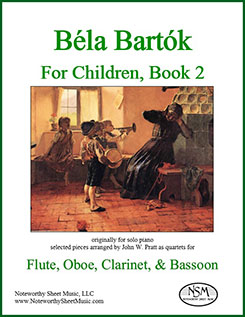 This edition presents seventeen of Bartók’s Book 2 Slovakian folksongs in arrangements for woodwind quartet (flute, oboe, B-flat clarinet, and bassoon). Four of these songs, Nos. 11, 14, 25 and 28, are also included in our trio arrangement publication, and several are included in the duo arrangement editions. The Book 2 songs arranged here as quartets are Nos. 5, 8, 11, 14, 15, 18, 23- 25, 27, 28, 30, 31, 34, 37, 38, and 43. Click to listen to a computer-generated audio sample that consists of ~32” of song #5 Bird in Flight (Theme & part of Var.1, through m34), followed immediately by #18 Former Flame in its entirety.
This edition presents seventeen of Bartók’s Book 2 Slovakian folksongs in arrangements for woodwind quartet (flute, oboe, B-flat clarinet, and bassoon). Four of these songs, Nos. 11, 14, 25 and 28, are also included in our trio arrangement publication, and several are included in the duo arrangement editions. The Book 2 songs arranged here as quartets are Nos. 5, 8, 11, 14, 15, 18, 23- 25, 27, 28, 30, 31, 34, 37, 38, and 43. Click to listen to a computer-generated audio sample that consists of ~32” of song #5 Bird in Flight (Theme & part of Var.1, through m34), followed immediately by #18 Former Flame in its entirety.
Preview: Book 2, Flute, Oboe, Clarinet, and Bassoon Quartet
Bauer – Sonata, Op.22 – Alto Saxophone
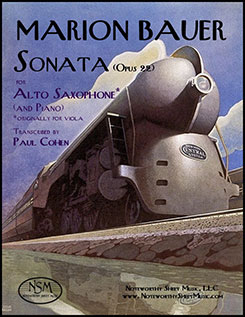 Sonata, Op.22, by Marion Bauer
Sonata, Op.22, by Marion Bauer
Transcribed for Alto Saxophone (and piano) by Paul Cohen (originally for viola and piano)
Alto Saxophone Part, PDF $11.79
Paul Cohen is one of America's most sought-after saxophonists for orchestral and chamber concerts and solo recitals. In addition to being a renowned performer and recording artist, he is also a talented arranger, lecturer, and collector of rare and historical instruments. Dr. Cohen holds MM and DMA degrees from the Manhattan School of Music; he currently serves on the faculties of the Manhattan School of Music and Rutgers University. We at NSM were pleased for the opportunity to collaborate with him on this publication of his transcription of Marion Bauer’s Sonata for alto saxophone.
from Dr. Paul Cohen’s preface to the NSM edition © April 7, 2021:
“Bauer composed this sonata in 1932 or 1935. It originally was written for viola, and dedicated to the memory of her friend and colleague, Albert Stoessel who was a distinguished American violinist, conductor, author, composer, and educator in the 20th century. Bauer soon after created her own idiomatic transcription for clarinet and piano, and the sonata was published as a work for viola or clarinet in 1951. It is revealing to see the differences in the viola and clarinet versions. The piano part remains unchanged in both.
 There is a history of music for viola successfully adapted for saxophone by the composers. Fernande Decruck’s Sonata (1943) for saxophone and piano (or orchestra) was originally written for viola, as was Ross Lee Finney’s Sonata in A Minor from 1937 (viola and piano), adapted for saxophone in the early 1970s. Several works for alto saxophone and orchestra written for the American saxophonist Elise Hall were originally written for viola, including Florent Schmitt’s Legende (1918) and Choral Variee´ (1903) by Vincent D’Indy. Adolph Busch composed his Suite for violin and either viola or alto saxophone in 1926, while in 1923 Darius Milhaud replaced the viola with the saxophone in La Creation du Monde literally positioning the saxophone in the viola chair in the string section. My saxophone adaptation of Bauer’s Sonata combines elements of the clarinet and viola versions, creating a version appropriate for the alto saxophone. This includes changes in range, articulation, phrasing and dynamics to create an idiomatic (though challenging) version for the alto saxophone faithful to the musical intent of the composer.”
There is a history of music for viola successfully adapted for saxophone by the composers. Fernande Decruck’s Sonata (1943) for saxophone and piano (or orchestra) was originally written for viola, as was Ross Lee Finney’s Sonata in A Minor from 1937 (viola and piano), adapted for saxophone in the early 1970s. Several works for alto saxophone and orchestra written for the American saxophonist Elise Hall were originally written for viola, including Florent Schmitt’s Legende (1918) and Choral Variee´ (1903) by Vincent D’Indy. Adolph Busch composed his Suite for violin and either viola or alto saxophone in 1926, while in 1923 Darius Milhaud replaced the viola with the saxophone in La Creation du Monde literally positioning the saxophone in the viola chair in the string section. My saxophone adaptation of Bauer’s Sonata combines elements of the clarinet and viola versions, creating a version appropriate for the alto saxophone. This includes changes in range, articulation, phrasing and dynamics to create an idiomatic (though challenging) version for the alto saxophone faithful to the musical intent of the composer.”
For additional information about Marion Bauer, please see the text excerpted from Peter H. Bloom’s preface to NSM’s 2014 publication of his transcription of the Sonata for alto flute.
We provide only the transcribed alto saxophone part in our edition; a pdf of the piano score is available from imslp.org.
Alto Saxophone Part, 11 pages; Total, 14 pages
Preview